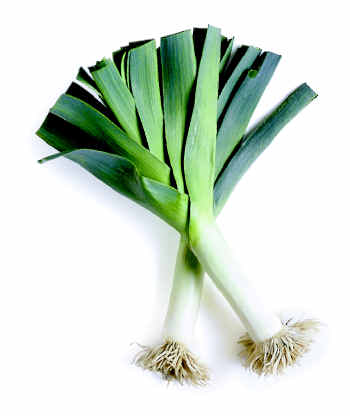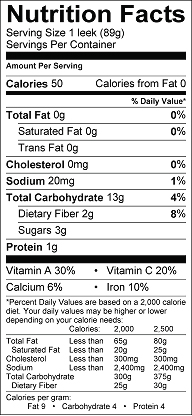Contents:
Common Names | Parts Usually Used | Plant(s) & Culture | Where Found | Medicinal Properties
Legends, Myths and Stories | Uses | Formulas or Dosages | Nutrient Content | How Sold | Warning | Bibliography
Scientific Names

- Allium porrum L.
- Allium tricoccum Ait.
- Lily family
Common Names
- Common leek
- Ramp
- Wild leek
Parts Usually Used
Bulb, lower stem
Back to Top
Description of Plant(s) and Culture
Leek is an annual, or sometimes perennial, plant; its linear leaves dilate at the bottom into leaf sheaths that surround the stem. The round stem grows from a slightly bulging bulb and is topped by a globular, umbellate cluster of white to light red flowers, with some small bulbs growing among the blossoms. Flowering time is June and July.
Another variety: Wild leek or Ramp (A. tricoccum) is strongly onion or leek scented; is similar to cultivated leek. Cherokees ate the leaves for colds, croup, and as a spring tonic. Warm juice of leaves and bulbs used for earaches. Similar to garlic in medicinal uses but less potent. Do not confuse Ramp with the poisonous Lily-of-the-Valley that it resembles.
Back to Top
Where Found
Usually grown by cultivation. Native to the moist woodlands of eastern-to-midwestern North America.
Back to Top
Medicinal Properties
Diuretic, stimulant
Back to Top
Legends, Myths and Stories
The word leek comes from the Anglo-Saxon name for the plant, leac. The leek, like its relatives the onion and garlic, has been known as a food plant for thousands of years. Over 1,200 years before Christ, the Israelites in the Sinai wilderness longed for the leeks, onions, garlic, meat and other foods they had known in Egypt (Numbers 11:4-6).
The emperor Nero ate great quantities of leeks under the delusion that they improved his voice.
Beginning in antiquity, soldiers of many centuries believed that carrying a leek in battle would assure safety and victory. In the 6th century, St. David, the patron saint of Wales, directed the Welshmen to wear leeks in their caps to identify themselves in their successful battle against Saxon invaders. To commemorate the victory, the leek was made the national emblem of Wales.
Back to Top
Uses
Leek has about the same properties as garlic, but to a lesser degree. It also stimulates appetite and helps to relieve congestion in the respiratory passages. Leek makes a good, non-irritating diuretic. The crushed leaves can be used externally to ease the sting of insect bites. Leeks are good for keeping blood vessels elastic and preventing premature aging. Eating plenty of the Allium varieties, such as chives, garlic, leeks, etc. will result in intestinal worms being eliminated.
Back to Top
Formulas or Dosages
Eat leeks lightly steamed or fresh in a salad.
Back to Top
Nutrient Content

How Sold
In the supermarket produce section.
Back to Top
Warning
Do not confuse leek with the poisonous Lily-of-the-Valley that it resembles.
Back to Top
Bibliography
![]() Culpeper’s Complete Herbal & English Physician: Updated With 117 Modern Herbs
Culpeper’s Complete Herbal & English Physician: Updated With 117 Modern Herbs, by Nicholas Culpeper, Meyerbooks, publisher, PO Box 427, Glenwood, Illinois 60425, 1990, (reprint of 1814)
![]() Eastern/Central Medicinal Plants
Eastern/Central Medicinal Plants, by Steven Foster and James A. Duke., Houghton Mifflin Company, 215 Park Avenue South, New York, NY 10000
![]() The Herb Book
The Herb Book, by John Lust, Bantam Books, 666 Fifth Avenue, New York, NY. copyright 1974.
Herbal Gardening, compiled by The Robison York State Herb Garden, Cornell Plantations, Matthaei Botanical Gardens of the University of Michigan, University of California Botanical Garden, Berkeley., Pantheon Books, Knopf Publishing Group, New York, 1994, first edition
 How Indians Use Wild Plants for Food, Medicine & Crafts
How Indians Use Wild Plants for Food, Medicine & Crafts, by Frances Densmore, Dover Publications, Inc., 180 Varick Street, New York, NY 10014, first printed by the United States Government Printing Office, Washington, in 1928, this Dover edition 1974
![]() The Nature Doctor: A Manual of Traditional and Complementary Medicine
The Nature Doctor: A Manual of Traditional and Complementary Medicine, by Dr. H.C.A. Vogel; Keats Publishing, Inc., 27 Pine Street (Box 876) New Canaan, CT. 06840-0876. Copyright Verlag A. Vogel, Teufen (AR) Switzerland 1952, 1991
![]() Planetary Herbology
Planetary Herbology, by Michael Tierra, C.A., N.D., O.M.D., Lotus Press, PO Box 325, Twin Lakes. WI 53181., Copyright 1988, published 1992
![]() Webster’s New World Dictionary
Webster’s New World Dictionary, Third College Edition, Victoria Neufeldt, Editor in Chief, New World Dictionaries: A Division of Simon & Schuster, Inc., 15 Columbus Circle, New York, NY 10023
 The Rodale Herb Book: How to Use, Grow, and Buy Nature’s Miracle Plants (An Organic gardening and farming book)
The Rodale Herb Book: How to Use, Grow, and Buy Nature’s Miracle Plants (An Organic gardening and farming book), edited by William H. Hylton, Rodale Press, Inc. Emmaus, PA, 18049., 1974
